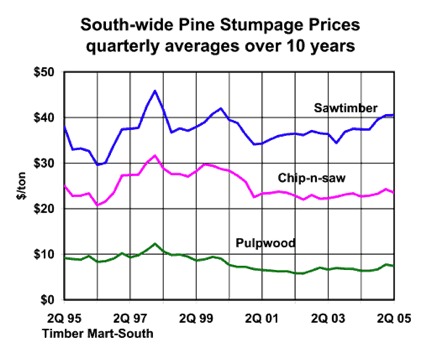By: C.D. Foster, J. Gan, and C. Mayfield
Forest landowners and rural communities can benefit economically from the utilization of biomass for bioenergy production. During the recent past, southern forest landowners have faced declining pulpwood markets which use small diameter and low value trees. As a result of this declining market, forest thinnings are often delayed. In addition, about 20 million dry tons of logging residues are available annually across the South for bioenergy production (Gan J, Smith CT 2006a). Using these materials as feedstock for bioenergy production creates additional markets and provides additional income to forest landowners.

For communities that depend on timber, market changes can have dramatic impacts on employment, stability, and viability. Many of these rural communities need additional markets in which to trade timber products. Utilizing logging residues, building processing facilities, and marketing the products created can bolster economic conditions in southern rural communities. In east Texas, the development of the bioenergy industry would create 1,338 jobs. The value-added would be about $215 million, while output would be $352 million (Gan J, Smith CT 2006b). These increases would be realized in logging procurement and electricity production from biomass salvaged from logging residues. An economic analysis in Georgia demonstrated that a biorefinery using 440 tons of biomass daily would generate 95 jobs and state tax revenue of $991,000 per year. Direct and indirect impacts from the goods and services produced at the plant would be about $33 million (Das and Treadgill 2005).
References
- Das KC, Threadgill ED. 2005. The Economic Potential of an Integrated Biorefinery Industry in Georgia: Conversion of Biomass to Fuels, Chemicals, and Value Added Products. Unpublished position paper provided to the Governor’s Agricultural Advisory Committee, Office of the Governor of Georgia. Report available upon request to the University of Georgia, Faculty of Engineering, Athens, Ga 30602.
- Foster CD, Gan J, Mayfield C. 2007. Advantages of Woody Biomass Utilization. Pages 35-38. In: Hubbard, W.; L. Biles; C. Mayfield; S. Ashton (Eds.). 2007. Sustainable Forestry for Bioenergy and Bio-based Products: Trainers Curriculum Notebook. Athens, GA: Southern Forest Research Partnership, Inc. [pdf]
- Gan J, Smith CT. 2006a. Availability of logging residues and potential for electricity production and carbon displacement in the US. Biomass and Bioenergy 30(12):1011–1020.
- Gan J, Smith CT. 2006b. Co-benefits of Utilizing Logging Residues for Bioenergy Production: The Case for East Texas, USA. Biomass and Bioenergy.
